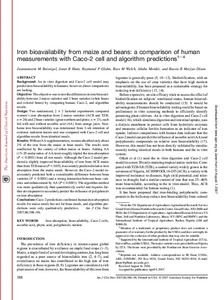| dc.contributor.author | Beiseigel, J.M. |
| dc.contributor.author | Hunt, J.R. |
| dc.contributor.author | Glahn, Raymond P. |
| dc.contributor.author | Welch, R.M. |
| dc.contributor.author | Menkir, A. |
| dc.contributor.author | Maziya-Dixon, B. |
| dc.date.accessioned | 2019-12-04T11:11:33Z |
| dc.date.available | 2019-12-04T11:11:33Z |
| dc.date.issued | 2007 |
| dc.identifier.citation | Beiseigel, J.M., Hunt, J.R., Glahn, R.P., Welch, R., Menkir, A.& Maziya-Dixon, B.B. (2007). Iron bioavailability from maize and beans: a comparison of human measurements with Caco-2 cell and algorithm predictions. The American Journal of Clinical Nutrition, 86(2), 388-396. |
| dc.identifier.issn | 0002-9165 |
| dc.identifier.uri | https://hdl.handle.net/20.500.12478/2451 |
| dc.description.abstract | Background: An in vitro digestion and Caco-2 cell model may predict iron bioavailability to humans; however, direct comparisons are lacking.
Objective: The objective was to test the differences in iron bioavailability between 2 maize varieties and 2 bean varieties (white beans and colored beans) by comparing human, Caco-2, and algorithm results.
Design: Two randomized, 2 × 2 factorial experiments compared women's iron absorption from 2 maize varieties (ACR and TZB; n = 26) and 2 bean varieties (great northern and pinto; n = 13), each fed with and without ascorbic acid (AA) from orange juice. Nonheme iron bioavailability was determined from 2-wk retention of extrinsic radioiron tracers and was compared with Caco-2 cell and algorithm results from identical meals.
Results: Without AA supplementation, women absorbed only about 2% of the iron from the maize or bean meals. The results were unaffected by the variety of either maize or beans. Adding AA (15–20 molar ratios of AA:iron) roughly tripled the iron absorption (P < 0.0001) from all test meals. Although the Caco-2 model predicted a slightly improved bioavailability of iron from ACR maize than from TZB maize (P < 0.05), it accurately predicted relative iron absorption from the maize meals. However, the Caco-2 model inaccurately predicted both a considerable difference between bean varieties (P < 0.0001) and a strong interaction between bean varieties and enhancement by AA (P < 0.0001). The algorithm method was more qualitatively than quantitatively useful and requires further development to accurately predict the influence of polyphenols on iron absorption.
Conclusions: Caco-2 predictions confirmed human iron absorption results for maize meals but not for bean meals, and algorithm predictions were only qualitatively predictive. |
| dc.format.extent | 388-396 |
| dc.language.iso | en |
| dc.subject | Bioavailability |
| dc.subject | Ascorbic Acid |
| dc.subject | Phytic Acid |
| dc.subject | Polyphenols |
| dc.subject | Tannins |
| dc.subject | Beans |
| dc.subject | Maize |
| dc.title | Iron bioavailability from maize and beans: a comparison of human measurements with Caco-2 cell and algorithm predictions |
| dc.type | Journal Article |
| dc.description.version | Peer Review |
| cg.contributor.affiliation | United States Department of Agriculture |
| cg.contributor.affiliation | International Institute of Tropical Agriculture |
| cg.coverage.region | Africa |
| cg.coverage.region | West Africa |
| cg.coverage.country | Nigeria |
| cg.creator.identifier | Abebe Menkir: 0000-0002-5907-9177 |
| cg.isijournal | ISI Journal |
| cg.authorship.types | CGIAR and advanced research institute |
| cg.iitasubject | Maize |
| cg.journal | American Journal of Clinical Nutrition |
| cg.howpublished | Formally Published |
| cg.accessibilitystatus | Limited Access |
| local.dspaceid | 93198 |
| cg.targetaudience | Scientists |

